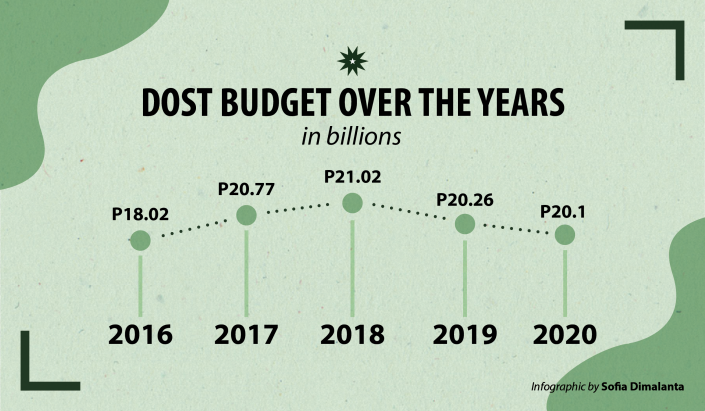Last September 2, the Department of Budget and Management approved a budget proposal of P20.18-billion for the Department of Science and Technology (DOST) for the year 2020—P79.85-million lower than the P20.26-billion allocated to the department in 2019.
This budget cut raised concerns among members of the House of Representatives, who have in turn pushed for an increase in the department’s budget. Addressing this, DOST Secretary Fortunato de la Peña highlighted their office’s achievements in a recent budget briefing of the House Committee on Appropriations, citing initiatives such as the Anti-Dengue program, the Malnutrition Reduction program, and the implementation of hybrid electric train-sets as some of their current endeavors that have impacted the Filipino people.
The DOST Secretary also stated how the country rose by 19 places in the latest Global Innovation Index—ranking 54th out of 129 countries—which he said was the outcome of his department’s collective efforts.
‘Not that significant’
But for DLSU Vice Chancellor for Research and Innovation Dr. Raymond Tan, the 0.4 percent budget decrease is “not that significant”.
“The budget is actually going to be reduced by a very small amount. If you do the numbers, it’s less than half a percent so it’s actually negligible,” reasons Tan. “In terms of whether that affects STEM (Science, Technology, Engineering, and Mathematics) development, I would not worry too much because in absolute terms, it’s a big figure, but as a percentage, it’s less than half a percent of the current year’s budget.”
Weighing in on the possible determinants that may have resulted to the lower budget allocation for 2020, Tan argues that expenditures in the previous year may have played a major role. Looking back on the previous year’s budget, DOST concentrated its efforts in augmenting five fundamental pillars—expanding the research and development pool, enhancing its services for firms and enterprises, developing its human resources, improving the disaster-readiness of the public and DOST staff alike, and rectifying governance in the DOST.
For the current year, the DOST has set its sights on accelerating and promoting the adoption of technology by inspiring an innovative culture along with establishing linkages between the academe and the industry.
Where the money goes

Budget appropriations to DOST is segregated to the different research institutes that fall under the department, whose breakdown of funding is shown in the review of the 2019 General Appropriations Act.
Roughly a quarter of the entire budget, or P4.5-billion, was provided to the Science Education Institute, which funds scholarships for those embarking in the STEM field. Moreover, Tan notes that a number of DOST scholars are currently enrolled in the University.
The next largest allocation, pegged at P2.6-billion, was given to the Philippine Science High School System; followed by the Philippine Atmospheric, Geophysical and Astronomical Services Administration, which was given P1.6-billion; and the Philippine Council for Agriculture, Aquatic, and Natural Resources Research and Development, which was granted P1.2-billion.
The remainder of the budget was allocated to the other various research institutes under DOST, such as the Food and Nutrition Research Institute, Advanced Science and Technology Institute, and the Philippine Institute of Volcanology and Seismology, among others.
Roadmap for the country’s future
Beyond budget allocations, national programs have also recently been geared to further STEM development. Tan says that the Philippine Development Plan (PDP), an initiative by the National Economic and Development Authority in 2017 which includes strategic policies, programs, and projects that will take precedence in the next 25 years, places STEM as a major component “to solve a lot of the problems of the country like poverty alleviation, improving conditions outside of the big cities, and so on.” STEM’s inclusion in the plans, the vice chancellor stresses, illustrates the government’s commitment to supporting the field.
In the fourth section of the PDP entitled Increasing Growth, there is a segment that outlines the strategies to be utilized for the advancement of science, technology, and innovation (STI). It delves into the utilization of STI in the agricultural, industrial, and service sectors while also highlighting the increase of investments in STI-based start-ups, enterprises, and by-products.
Tan also shares how funding for research has improved. Fifteen years ago, receiving a P1-million research grant from government agencies was already viewed as an achievement. He recounts, “Ngayon na there’s so much funding available because there’s so much trust in both STEM and DLSU specifically; P1-million is sort of the minimum.”
“The good news is that there are more resources to support STEM activities and scholars,” he adds.
Even so, Tan admits that the Philippines has a long way to go before it can catch up to other countries, especially when it comes to research. Nevertheless, he remains adamant, saying, “We’re sort of late in the game as a country, but we’re fighting hard to catch up.”

One reply on “Scrutinizing the lower 2020 budget allocation for DOST”
[…] [3] The Lasallian. (October 9, 2019). Scrutinizing the lower 2020 budget allocation for DOST. https://thelasallian.com/2019/10/09/scrutinizing-the-lower-2020-budget-allocation-for-dost/ […]